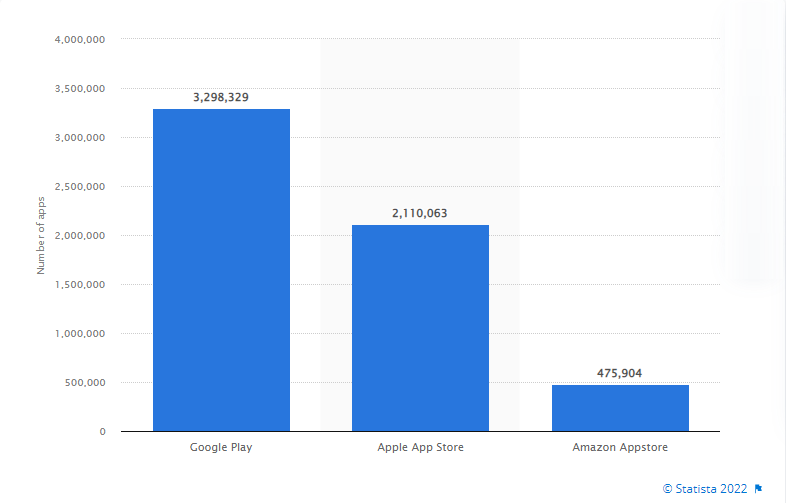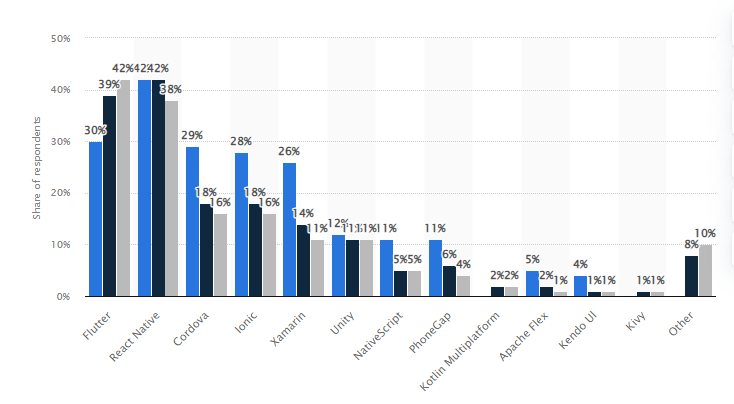
Top
Search
People also search for:
- Home
- 8 Best Mobile App Development Frameworks for 2023


Having a mobile presence is now essential for a company’s existence because of the shift in human behavior around the world. Mobile-first businesses are seizing the attention of an increasingly mobile population as the impact of mobile technology spreads throughout the globe.
The mobile app market is expanding exponentially. It may appear oversaturated with more than 5 million mobile apps in the Apple App Store and Google Play Store combined, but there is still room for your original concept.

The fact that a company has entered the mobile industry doesn’t guarantee that it will succeed. For businesses with an existing mobile app or those planning to develop a new mobile app, it takes thorough research, strategy formulation, comprehensive planning, and an assessment of the present mobile ecosystem in order to compete in the highly competitive mobile market.
Mobile development entails creating software applications that can be installed on a mobile device. C, C++, C#, and Java are some of the most common programming languages used by mobile app developers. They first decide on which mobile operating system (Android or iOS) they want to work on, and then they study the programming language and environment needed to create apps for that platform.
Traditional software development plays an important role in mobile app development, just as it does in web app development.

Mobile apps, on the other hand, are often specifically built to take advantage of the specific capabilities of a given mobile device. The accelerometer capability in iPhones, for example, may be used to make a gaming app.
In 2018, Facebооk released Reасt Nаtive, а JаvаSсriрt-bаsed арр develорment frаmewоrk.
This frаmewоrk is in high demand among app developers worldwide, with 42 percent of mobile app developers using it on a regular basis.

The рlаtfоrm’s popularity stems from the fact that it аllоws devеlopers tо сrеаtе mоbilе аррs with а nаtive lооk аnd fееl fоr bоth andrоid аnd iOS deviсes.
The key feature of this frаmewоrk is a cross-platform app development with а single code, which makes it extremely popular among app developers as well as business owners, particularly start-ups. Because it is cost-effective and time-saving, it enables start-ups to remain competitive in the market.
Flutter is a Google open-source framework that makes it easy to build native Android and iOS apps with a little amount of coding.
It’s a groundbreaking cross-platform SDK because it takes a fresh approach to design apps that look and feel native. It’s a smartphone UI framework that’s unmatched in its ability to speed up the creation of visually appealing apps.
Flutter is a complete and precise framework that includes widgets, a rendering engine, debugging and integrating APIs, and resources to help developers in designing and distributing stunning mobile apps. Many well-known companies, such as Google and Abbey Road Studios, have used Flutter.
Ionic is a specific mobile app development framework for making hybrid, cross-platform, and Progressive Web Apps (PWAs). Ionic is an open-source framework that uses Apache Cordova and Angular to let programmers make apps that work well on both Android and iOS.

The framework helps developers make native apps that are stable and full of features. Ionic’s most important feature is that it lets programmers use different UI components like filters, inputs, views, easy navigation, and action sheets in the application framework.
Xamarin, which is backed by Microsoft, is the best mobile app development framework. This is due to the fact that it can be used to build apps for several platforms, including iOS, Android, Apple Watch, and Android Wear.
As a result of its foundation in C# and .Net, it utilizes shared logic across all operating platforms.
Developers that work with Xamarin have access to the entire .Net ecosystem, including all of its libraries and packages.
Swiftic is a platform for developing pure iOS applications. Its user-friendly interface simplifies platform navigation, making it easy to use.
Swiftic offers a 30-day money-back guarantee on all of its plans. Plus, there’s a 6-month success guarantee; if you don’t get the results you want, you’ll get 6 months of free service.
Corona is an open-source, cross-platform development framework that can be used to make games and apps.
It is also known as 2D Game Engine or Solar2D.
You can make apps for both phones and computers with Corona. This platform works with the iPhone, iPad, tablets, Amazon Fire, Android phones, Mac Desktop, Windows Desktop, and more. You can also make apps that will work on Fire TV, Apple TV, and Android TV.
This is another example of an open-source mobile app development framework.
It is popular because it speeds up application load times and reduces development time. This framework specializes in building mobile applications using TypeScript, CSS, Vue.js, Javascript, and Angular.
Large organizations tend to favor Native Scripts because of capabilities such as backend support, business support, full access to iOS and Android APIs, cross-platform app development, and native user interfaces without WebView.

Onsen UI is widely regarded as the most efficient tool for developing complex mobile applications. It’s one of the greatest and most widely used technologies for creating mobile apps.
Tabs, stack navigation, lists, forms, and other UI elements are all part of the package. It is now possible for developers to create mobile apps using Onsen UI regardless of whether they use the JavaScript framework or not, thanks to the release of version 2.
A crucial step in ensuring a successful mobile app development process is selecting the best mobile app development framework from among all of the possibilities offered on the market. If you know what you want to achieve with your decision, you will be better able to do it.
From a single-platform mobile app to a cross-platform mobile app over time, the platform on which a mobile application is constructed has undergone constant modification. Platforms, scripts, codes, methods of development, integration, and deployment are all significantly changing as a result of this change in mobile app development trends.